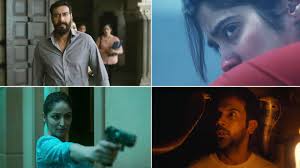The Indian cinema is known for its glamorous dance sequences, extravagantly spectacular romances and heroes who kick box. But there is something else that has been percolating for the past 10 years, a change of heart so to speak, is the emergence of dark Indian cinema. And movies that explore subjects like psychological trauma, crime, social injustice and moral ambiguity are increasingly winning critical favor and passionate fans outside of Indian borders. But there’s something about their raw emotion and brutal honesty that makes all of these dirty, dark tales irresistible.
What Defines Dark Indian Cinema?
Themes and Tone
Dark Indian cinema refers to films that explore intense and often uncomfortable themes, such as:
- Crime and Corruption
- Mental Health and Trauma
- Caste and Social Discrimination
- Domestic Violence and Gender Inequality
- Existential Angst and Urban Alienation
These films often forgo typical Bollywood tropes in favor of realism, character complexity, and a moral gray zone.
H2: Stylistic Choices
These films tend to adopt a subdued color palette, slow pacing, and minimal background score. Directors use these techniques to heighten emotional tension and create a claustrophobic atmosphere that mirrors the characters’ internal struggles.
The Evolution of Indian Storytelling
From Masala to Minimalism
Historically, mainstream Indian cinema, particularly Bollywood, has prioritized escapism. However, with the emergence of parallel cinema in the 1970s and later independent films, the tone started shifting. Directors like Satyajit Ray and Shyam Benegal laid the groundwork for serious storytelling, which modern filmmakers have taken even further.
Rise of Regional Cinema
Some of the darkest, most compelling narratives have come from regional industries like Marathi, Malayalam, and Tamil cinema. These industries often have fewer commercial constraints, allowing for greater experimentation with themes and style.
Why Global Audiences Are Taking Notice
Universality of Themes
Issues like injustice, psychological trauma, and inequality are globally relevant. Films such as Gangs of Wasseypur, Paatal Lok, and Tumbbad resonate with international audiences because their core themes transcend cultural barriers.
Streaming Platforms as a Gateway
The explosion of platforms like Netflix, Amazon Prime, and Disney+ has made it easier for non-Indian audiences to access and appreciate Indian content. Subtitles and dubbing options further lower the entry barrier.
Awards and Festival Circuits
Dark Indian films are frequently showcased at international film festivals, earning critical acclaim. For example:
- Court (Marathi) was India’s official entry to the Oscars.
- The Disciple (Marathi) won Best Screenplay at Venice Film Festival.
Key Films That Redefined Dark Indian Cinema
Gangs of Wasseypur (2012)
Directed by Anurag Kashyap, this two-part crime epic chronicles decades of blood feuds in the coal mafia of Dhanbad. It brought a Tarantino-esque flair to Indian storytelling.
Tumbbad (2018)
A visually stunning horror-fantasy that explores greed and mythology. Its atmospheric cinematography and slow-burning narrative captivated global viewers.
Talvar (2015)
Based on the real-life Noida double murder case, this film is a riveting crime drama that critiques India’s justice system.
Paatal Lok (2020)
A gritty web series on Amazon Prime that mixes noir crime storytelling with social commentary, focusing on caste, media, and police brutality.
Cultural and Social Relevance
Reflecting India’s Underbelly
Dark Indian cinema often serves as a mirror to the darker aspects of Indian society. These films raise awareness about systemic issues and offer a platform for voices usually marginalized in mainstream narratives.
Bridging the Rural-Urban Divide
Many of these films explore how rapid urbanization and socio-economic disparities affect individual lives, making them relatable to both domestic and international viewers.
The Role of Technology and AI in Film Creation and Distribution
H2: Data-Driven Production
Modern Indian filmmakers are leveraging analytics to understand audience preferences. AI tools can predict trends, assess script potential, and even recommend edits, thereby enhancing storytelling quality.
H2: Targeted Marketing Through Automation
Automation allows for more efficient marketing strategies that cater to segmented global audiences. Dark Indian cinema benefits from personalized recommendations on platforms like Netflix and YouTube.
Future Prospects for Dark Indian Cinema
Expanding Global Collaborations
As the appeal of Indian dark cinema grows, international co-productions are becoming more common. These collaborations promise higher production values and wider releases.
Empowering Indie Voices
With fewer gatekeepers, indie filmmakers now have a better shot at telling raw, authentic stories without compromise. Crowdfunding and social media promotion are democratizing the film landscape.
The attraction of dark Indian cinema, for me, is that it is honest, deep and has the courage to face unpleasant realities. As global audiences become more discerning, wanting to experience the world with fresh eyes, viewers are looking towards diverse narratives as an antidote to stale storylines. With the help of technology, global platforms, as well as increasing critical appreciation, hipster Indian cinema isn’t just a fad right now it’s a literal movement, changing the global perception of what Indian stories can look like.
FAQ
What makes a film “dark” in Indian cinema?
A dark Indian film typically explores themes like crime, trauma, injustice, and psychological depth, often with a serious or somber tone.
Why is dark Indian cinema becoming popular globally?
These films resonate universally due to their raw emotional appeal and exploration of issues that cross cultural boundaries.
Are these films available with English subtitles?
Yes, most dark Indian films on platforms like Netflix and Amazon Prime offer English subtitles and sometimes dubbed versions.
How does technology support the growth of this genre?
AI and data analytics help filmmakers understand audience preferences, while automation enables global distribution and targeted marketing.
What are some must-watch dark Indian films?
Top picks include Gangs of Wasseypur, Tumbbad, Talvar, and Paatal Lok for their storytelling and international appeal.